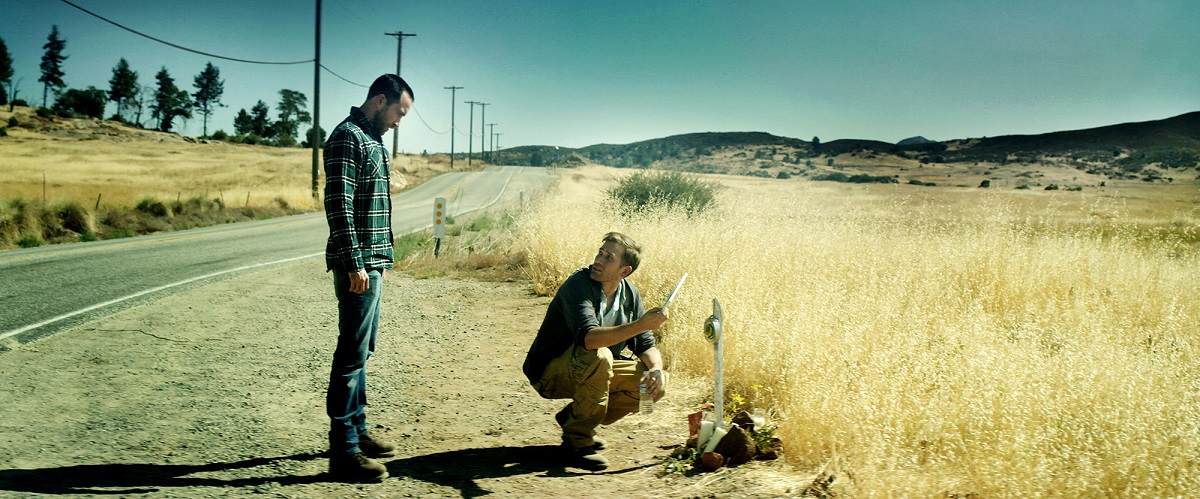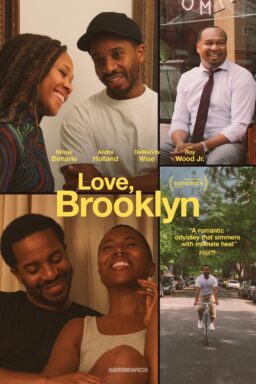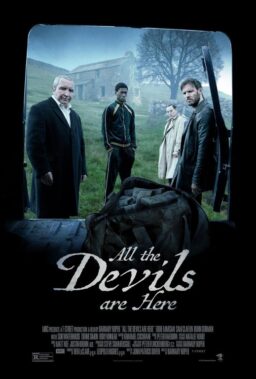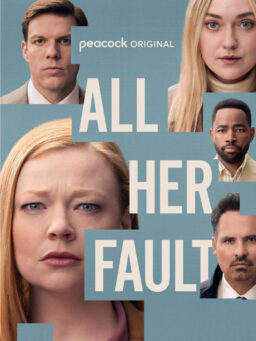Rotten Tomatoes may be the whipping post for a lot of people nowadays but it’s still worth noting that Justin Benson & Aaron Moorhead’s newest film, the fascinating “The Endless,” has 35 reviews on the aggregator, and every single one of them is ‘Fresh.’ Yep, it’s one of those rare 100% movies, at least as of this writing. And yet, because it’s coming out at an incredibly crowded time of the year for quality cinema, it’s the kind of film that could slip under your radar. Don’t let that happen.
Since the film’s premiere at Tribeca last year, it’s become one of the most talked-about genre films of the ‘10s, and it deserves its buzz. The writer/directors also star as, you guessed it, brothers named Justin and Aaron. Their characters escaped a doomsday cult almost a decade ago, but the younger Aaron has romanticized his time there, wondering if they ever should have left in the first place. Mostly to get his brother to shut up, Justin agrees to go back to the camp, and what they find there … well, I wouldn’t dare spoil it and it works better if you see it than if you read about it.
When I saw it at Fantasia Fest last year, I wrote, ““The Endless” becomes a film about our destructive patterns more than anything else, about how easily we can fall into routines that keep us stuck from actually going anywhere in life. It is a clever film in the way it weds the impossible with the relatable, finding the human stories that allow us to suspend disbelief as the film gets further away from reality. As with so many great filmmakers, they ground us with emotion, so they can take us anywhere they want to with their storytelling.”
Justin and Aaron gave me a call this week to talk about their style, how they ground their films, the movies they like recently, and how to get this film above the noise.
While your films qualify as genre films, they’re built on dramatic, human, emotional foundations. Why is that important to your filmmaking?
JUSTIN BENSON: Our instinct has always been to get people to care about the characters via making them feel like real human beings—and hopefully not real human beings you’ve seen in movies a lot but people you recognize from your own life. And, if you can get that stuff across, when the dangerous stuff happens, there’s so much more tension because the audience truly cares about a character as a real human being as opposed to caring about a character as an archetype. We have a theory that it’s more effective.
How personal are these stories or what these characters are going through?
AARON MOORHEAD: They’re definitely personal without every straying into being autobiographical at all. We always make a film about something thematically that’s important to us. Sometimes what we want to explore, like in “Spring,” exploring the more dangerous nature of love—that was something that was borne out of the story. But with “The Endless,” it was something that we were feeling at the time … we were a little stuck in our careers and noticed that a lot of stuff that we were developing had to do with rebellion and anti-conformity. So we decided to put that idea right up on the peg board—let’s make a movie exactly about that. Before we knew about the characters or sci-fi, we knew it was going to be a movie about when it’s right to take action for yourself, and sometimes when it’s wrong.
Did “Spring” start from a similar non-genre peg?
JB: It was two things. For whatever reason, I had this idea about what if a person could live immortally if they could metabolize their own embryonic stem cells. So there was that as a high concept thing. With every movie, I can kind of track my relationship with my mom. She had a lot of substance abuse problems—so with “Resolution” I came up with the idea of this guy imprisoning this strange junkie in a cabin in the woods because after everything we had been through together with her substance abuse issues, I thought ‘well, this is the one thing a person could do.’ And then with “Spring,” things had gotten pretty bad and she had almost passed away a few times and struggled with depression, and I thought ‘well, what would I do if I was in her situation?’ I’d take off to Western Europe, which makes me feel happy and recover.

I’m struck by how much you guys play with what we don’t see. The other end of the rope, staying above water when Justin goes under, etc. Can you speak a bit about the power of what’s unseen in your film and others?
AM: There’s a two-fold reason for that. The movie starts on that Lovecraft quote: “The oldest and strongest emotion of mankind is fear, and the oldest and strongest kind of fear is fear of the unknown.” And so we wanted to try and follow that up. And we realize that when the human mind doesn’t get to see it then they fill in the blanks as a coping mechanism, and it’s even more frightening if you can do it right. The issue is that it can feel like you’re pulling the rug out from under your audience if you keep on making it so you don’t see ‘the thing.’ Seeing is knowing and knowing is to not do something. We wanted to keep it more of the effect more than the thing. And the other aspect is the budget. We don’t have the budget to [show everything]. Even if we had the budget, we probably would have failed. So we try to lean into this concept of not seeing. Of course, we still have a few payoff moments. We make sure we’re not constantly twirling our mustaches behind the camera. That was the trick—finding the way to pay it off without showing too much.
There’s a very tactile quality to the film. We all know what throwing a baseball feels like, what pulling a rope feels like, the grainy quality of the VHS—these elements make it relatable and timeless. Was that intentional or just a product of your setting or am I reading too much into it?
JB: The funny answer is ‘Maybe?’ We never had a conversation about it being tactile, but you’re right that it’s there. It’s a very analog film, for sure. For one thing, spoiler alert, one does find out halfway throughout the movie that they’ve all been suspended in time. For example, if Shane was playing with a fidget spinner … [laughs]. There’s stuff like that for a logical reason. And when you use a rope for something in a story like that, there’s no avoiding that you’re using a powerful symbol for something. I have a cheesy book in my apartment called The Book of Symbols. I bet there’s a rope in it.
Did you always want to play the leads? Did you ever consider not?
AM: When we started the movie, it was kind of a rebellious idea on its own. We were thinking about making a self-reliant movie. We’ll finance it. I’ll be the cinematographer, editor, all that. If we’re gonna be self-reliant, one of the most self-reliant things we can do is also be the leads. Once we got more legitimate financing, there was not really a question. It was still low enough that we didn’t need main talent to be in any of the roles. We had already rehearsed it. The movie ended up being built around our strengths. So, no. But we did have to audition for our producer Gabe. That was frightening. [Laughs]
JB: Aaron and I, before we even met ten years ago, were doing DIY films, where you’re everything from the craft services guy to the electrician to the director to the actor. I think there’s an ethos that carries forward from that that everything on set is filmmaking. You participate in it as a filmmaker, and that includes acting. Six or seven years ago, we were at this festival in Sweden with a writer/director/actor named Amy Seimetz. She’s someone who, just as a person I met briefly, was saying exactly what I just said. All filmmaking, if you’re a filmmaker, you should try your hand at acting. Do everything you possibly can.

What films, art, literature inspired this film specifically, if anything?
AM: I’m sure things like “LOST” and “The Twilight Zone” factor in there, but actually the much larger ideas weren’t so much sci-fi ideas or even character ideas as much as they were going back to the ethos of doing our own movie. We watched “Manson Family Vacation,” for example. It’s a hard drama. It’s Duplass-produced and acted drama. ‘They have huge careers and they’re running off and producing and starring in these tiny movies—let’s go do that!’ Steven Soderbergh—he just does anything and that’s part of his style now; it’s not something he waits for. That was it on the filmmaking side. But a lot of books, actually, inspired the film. Of course, there’s pieces of Lovecraft, but less than you’d think. The Color Out of Space comes to mind. Mountains of Madness comes to mind. Even more than that, it’s more of a tone thing than a science thing. People who read Lovecraft are more the inspiration for us. Even the pop ones like Stephen King and Alan Moore and Neil Gaiman.
Who do you read/like/watch now?
JB: The best movie we both saw in the last couple months was “20th Century Women” by Mike Mills. That blew us away. Independently. We both watched it separately and both had stories about crying in our rooms. It’s such an emotional punch, such a good film. “The Florida Project.”
AM: I’m from Florida and drive by places like that all the time. I know the job of that movie wasn’t to capture Florida but it still did it very well.
Both stories about mothers and children too. Even if in very different ways.
JB: “Annihilation” got me! You could point out its flaws if you want to but I was just so overwhelmed by the end. So impressed.
Speaking of that, a movie people feel is unloved, the market is so crowded nowadays—how does a film like this get seen? How do you rise above the noise?
AM: I don’t know.
JB: You tell me. [Laughs]. It’s tricky. You almost get above the noise because our release isn’t wide enough. You don’t go to this website and find it. The release isn’t constructed to have that kind of thing. But what we do aim for is that where it is playing everybody knows about it. I don’t have the answer to that one, but …
Localized publicity.
JB: Not billboards and bus stops—what our distributor is doing is very very targeted Facebook ads. And I know that’s a thing to talk about right now, but that’s exactly what it is—find people who liked the “Annihilation” trailer and make sure they see the “The Endless” trailer.
Ah, Facebook ads. What are you guys working on now?
JB: We never know what’s next but we always have ten projects we’re working on and we see what goes. We’ve got bigger projects, and usually the bigger they are the slower they move. You need a celebrity cast to get its made. Those reads take months. All of these projects will happen eventually. In the meantime, we’ll never stop making movies while waiting for these bigger ones to happen. And that includes movies and TV shows.












